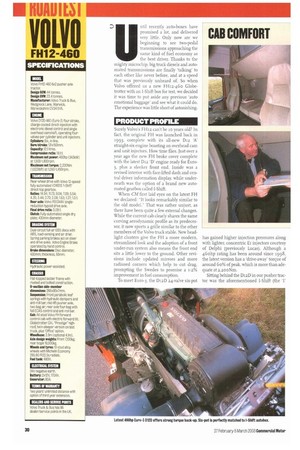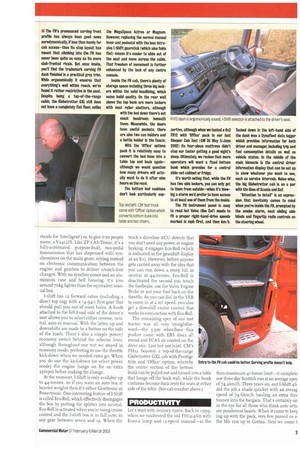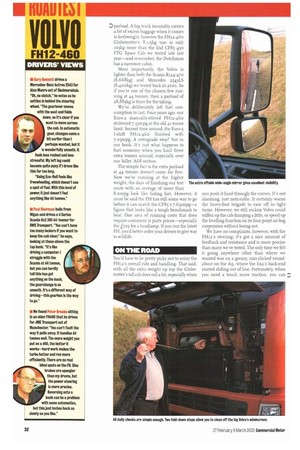Z A ,\ D) Es)k
Page 28

Page 30

Page 31

Page 32

Page 34

If you've noticed an error in this article please click here to report it so we can fix it.
VOLVO FH12-460
IPRICE AS TESTED: 1911974 (ex-VAT)*. ENGINE: 12.1 litres, 460hp (343Inv). GCW :44 tonnes. PAYLOAD : 28.89 tonnes. AVERAGE SPEED: 74.5km/h (46.3mph). AVERAGE FUEL CONSUMPTION: 7.05mpg (40.07 lit/100km).
*(Indudes basic chassis. £89.839: blind spot mirror. LSI air kit £1.388:Dynsfiset £3.69t) We've heard all the arguments before: the trouble with automated truck transmissions is they can't see the road ahead like the man behind the wheel. Who cares? The computing power and speed of Volvo's new I-Shift auto, coupled with the latest 46ohp DI2D diesel make the latest MI2 one hell of a 44-tonner. In fact, it's so good you'll give your left leg to have one. Unconvinced? Read on...
D ntil recently auto-boxes have promised a lot, and delivered very little. Only now are we beginning to see two-pedal transmissions approaching the same kind of fuel economy as the best driver. Thanks to the mighty microchip, big truck diesels and automated transmissions are finally 'talking' to each other like never before, and at a speed that was previously unheard of. So when Volvo offered us a new FH12-46o Globetrotter with an I-Shift box for test, we decided it was time to put aside any previous 'auto emotional baggage and see what it could do. The experience was little short of astonishing.
PRODUCT PROFILE Surely Volvo's F H i2 can't be io years old? In fact, the original FH was launched back in 1993, complete with its all-new Du `A' straight-six engine boasting an overhead cam and unit injectors. How time flies. just over a year ago the new FH broke cover complete with the latest D12 D' engine ready for Euro3, plus a sleeker front end. Inside was a revised interior with face-lifted dash and central driver information display. while underneath was the option of a brand new automated gearbox called I-Shift.
When CM first laid eyes on the latest FH we declared: "It looks remarkably similar to the old model." That was rather unjust, as there have been quite a few external changes. While the current cab clearly shares the same curving aerodynamic profile as its predecessor, it now sports a grille similar to the other members of the Volvo truck stable. New headlight clusters give the FH a more modern, streamlined look and the adoption of a front under-run system also means the front end sits a little lower to the ground. Other revisions include updated mirrors and more radiused corners which help to cut drag, prompting the Swedes to promise a 1-2% improvement in fuel consumption.
To meet Euro-3, the Di2D 24-valve six-pot has gained higher injection pressures along with lighter, concentric Er injectors courtesy of Delphi (previously Lucas). Although a 46ohp rating has been around since 1998, the latest version has a 'drive-away' torque of around 6o% of peak, which is more than adequate at 2,200Nm.
Sitting behind the Di2D in our pusher tractor was the aforementioned I-Shift (the 'I' stands for 'Intelligent') or, to give it its proper name, a V2412I S . Like ZF's AS-Tronic, it's a fully-automated, purpose-built, two-pedal transmission that has dispensed with synchronisers on the main gears, relying instead on electronic communication between the engine and gearbox to deliver crunch-free changes. With no synchro cones and an aluminium case and bell housing, it's also around 70kg lighter than the equivalent manual box.
I-shift has ra forward ratios (including a direct top cog) with a 14.94:1 first gear that should pull you out of most holes. A knob attached to the left-hand side of the driver's seat allows you to select either reverse, neutral, auto or manual. With the latter, up and downshifts are made by a button on the side of the knob. There's also a simple power/ economy switch behind the selector lever. although throughout our test we stayed in economy mode, preferring to use the throttle kick-down when we needed extra go. When you do use the kick-down (or select power mode) the engine hangs on for an extra 25orpm before making the change.
At the moment, I-Shift is only available up to 44-tonnes, so if you want an auto box at heavier weights then it's either Geartronic or Powertronic. One interesting feature of I-Shift is called Eco-Roll, which effectively disengages the box by putting the splitter into neutral. EcoRoll is activated when you're using cruise control and the I-shift box is in full auto, in any gear between seven and 12. When the
truck's driveline ECU detects that you don't need any power, or engine braking, it engages Eco-Roll (which is indicated in the gearshift display as an E+). However, before anyone gets carried away with the idea that you can run down a steep hill in neutral at 44-tonnes, Eco-Roll is deactivated the second you touch the footbrake, use the Volvo Engine Brake or put your foot back on the throttle. As you can dial in the VEB to come in at a set speed, you also et a downhill cruise control that works in conjunction with Eco-Roll.
The remaining spec of our test tractor was all very straightforward—the 3.9m wheelbase 6x2 pusher came with EBS discs all round and ECAS air control on the drive axle. Last but not least, CM'S Fl-li2 boasted a top-of-the-range Globetrotter GXL cab with Prestige trim and `Office' option, whereby Entry to the HI cab could be better. Curving profile doesn't help. the centre section of the bottom
bunk can be pulled out and turned into a table that hangs off the back wall, while the bunk cushions become back rests for scats at either side of the table. (See cab comfort above.)
PRODUCTIVITY
Let's start with journey times. Back in 1999. when we roadtested the old FH12-46o with Euro-a lump and 12-speed manual—at the then-maximum 41-tonne limit—n complete our three-day Scottish run at an average spee of 74.2km/h. Three years on, our I-Shift 46 did the job a shade quicker with an averag speed of 74.6km/h hauling an extra thre tonnes into the bargain. That's certainly on in the eye for all those who think auto artk are ponderous beasts. When it came to keel ing up with the pack, very few passed us o the MG run up to Gretna. Next we come t payload. A big truck invariably carries a bit of excess baggage when it comes to kerbweight, however the FH12-46o Globetrotter's 8,1151(g tare is only 105kg more than the Daf CF85 430 FTG Space Cab we tested late last year—and remember, the Dutchman has a narrower cabin.
More importantly, the Volvo is lighter than both the Scania 12124-47o l8,668kg) and Mercedes 2543LS l8,400kg) we tested back in 2001. So if you're one of the chosen few running at 44 tonnes, then a payload of 28,885kg is there for the taking.
We've deliberately left fuel consumption to last. Four years ago, our Euro-2 manually-stirred F1-112-46o delivered 7.mpg at the old 41-tonne limit. Second time around, the Euro-3 I-shift FH12-46o finished with 7.05mpg. A retrograde step? Not in our book. It's just what happens to fuel economy when you haul three extra tonnes around, especially over our 'killer' A68 section.
The simple fact is the extra payload at 44 tonnes doesn't come for free. Now we're running at the higher weight, the days of finishing our test route with an average of more than 8.0rnpg look like fading fast. However, it must be said the FH has still some way to go before it can match the CF85's 7.69mpg—a figure that looks like a tough benchmark to beat. One area of running costs that does require comment is parts prices—especially the f7o3 for a headlamp. If you run the latest FH, you'd better order your drivers to give way to wildlife.
ON THE ROAD
You'd have to be pretty picky not to enjoy the FH12's overall ride and handling. That said, with all the extra weight up top the Globetrotter's tall cab does roll a bit, especially when you push it hard through the curves. It's riot alarming, just noticeable. It certainly warns the heavy-foot brigade to ease off in tight turns. However, we still reckon Volvo could stiffen up the cab damping a little, or speed up the levelling function on its four-point air-bag suspension without losing out.
We have no complaints, however, with the steering; it's got a nice amount of feedback and resistance and is more precise than many we've tested. The only time we felt it going anywhere other than where we wanted was on a greasy, rain-slicked roundabout on the A9, where the 6x2's back-end started sliding out of line. Fortunately, when you need a touch more traction, you can
D quickly dump the second axle air using the dash-mounted switch. In common with other 6x2s we've driven, the FFII2's second (pusher) axle also tramps a bit when it hits a poorly-fitting manhole cover or bad bump.
Volvo's mirror pack ensures good vision, especially as our test tractor had an extra wideangle mirror on the driver's side and a Japanese-style blind-spot mirror for the front bumper. The wide gap between the solidlymounted mirror arms and the A-post also helps overcome the traditional blind spot when coming onto roundabouts.
After whetting your appetite for I-Shift, it's about time we told you what it's like to use. There are basically four steps: fire up the engine; select auto with the gear knob; release the park brake; press down on the throttle... and go. It's that simple. We could go on for hours about the features of 1-Shift but instead, we'll simply say it's the most intuitive auto we've driven. It's not important that it can't physically 'see' the road ahead. It reacts to any situation with such a phenomenal speed that it doesn't matter.
Based on our previous experience with autos, we fully expected to have to take control over the 'severe gradients' section of CM'S test route. In fact, the big Swede shrugged off the worst bits of the A68 in full-auto made and even threw in a few surprises of its own. On some of the speed-sapping I-in-7 climbs, I-Shift was actually changing up the box—at moments when you wouldn't have dared to with a manual box. By the time you could have dipped the clutch, moved the lever, lifted the clutch and re-applied the throttle, a fullyladen 44-tonner would have ground to a halt. Not so with I-Shift. Moreover, its changes are so smooth as to be virtually seamless.
In auto mode, it normally pulls away in 2nd—although in tight spots and hills you can manually select first then hold it for ultimate control before re-selecting auto and letting I-Shift take over again. And when you're done with manual, simply push it back into auto.
Thanks to the microchip, the D1213 diesel and 1-Shift 'chat' away to each other with never a cross word, so the 12-litre lump is invariably left spinning in the green band, set between Lioo and 1,750rpm. The 460hp sixpot is a very torquey performer, pulling hard around 1,3oo-1,400rpm and down to i,000rpm before corning back fighting.
Unlike the first generation autos, I-Shift changes when it thinks conditions are right to hold the next gear—rather than at a fixed point on the rev counter. As a result, it's a far more fluid drive all round, with the box responding instantly to individual driving style and power demand.
We love the Eco-Roll function, and encour
aged it to kick in at every opportunity by easing off the throttle as soon as possible. Only on the odd occasion did it seem 'confused', dithering between a gear and E+ before finally making up its mind.
The combination of I-Shift and the Volvo Engine Brake together provide impressive secondary braking plus a downhill cruise control which dials in the VEB to keep you to your pre-selected set speed. Using the steering column-mounted lever, you can also adjust the level of retardation from the VEB, based on the number of cylinders that are turned into a compressor.
On the track, the F EBS discs felt fine, delivering high peak deceleration readings. However, with an extra three tonnes on-board overall, stopping distances for 44-tonners are inevitably creeping up.
SUMMARY
We admit that we've taken a pretty jaundiced view when it's come to automated heavy truck transmissions.
However, Volvo has finally produced the ultimate 'point-andshoot' auto that
truck makers have long threatened—but never quite delivered. I-Shift really can think for itself, and the speed with which it adjusts to the terrain is little short of astounding. The T means it's more than just intelligent, it's idiot proof. Put it in a fleet and, thanks to its consistency, it also has the potential to finally end the wild variations in fuel returns between your drivers—no matter who's behind the wheel.
But this isn't just a transmission test. With I-Shift sitting behind the latest Di2D 460, you've got a very driveable truck that's totally on top of the job thanks to the latter's excellent torque characteristics and good journey times.
Admittedly the big Swede's fuel consumption isn't record-breaking, but then neither was its Euro-2 predecessor. However, if you don't need 44 tonnes it can only get better, and we were also pleasantly surprised by the FH's kerbweight too.
Meanwhile, at a time when driver retention is reaching crisis point, a Volvo FH12-46o Globetrotter with I-Shift is an extremely strong trump card.
• by Brian Weatherley


































































































































































